Of all the slums in inner Melbourne, ‘Little Lon’ was the most notorious. You can see where it was located in the map below.
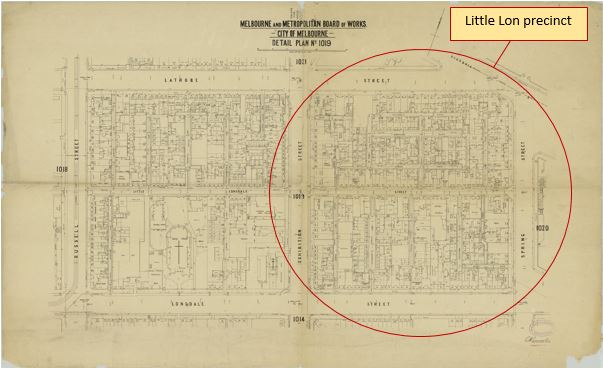
Most of Little Lon’s original residents were Irish, but by the 1900s, the area was home to people from countries as disparate as Syria, China, Germany, India and Italy.1 This 1900 Sands & McDougall directory listing from the precinct was typical:
Families as large as nine and ten dwelled in small, two-room workers’ cottages. Entrepreneurial types started their own small businesses. Others eked out a living as best they could as hawkers and factory hands, laundry workers and shop assistants.2
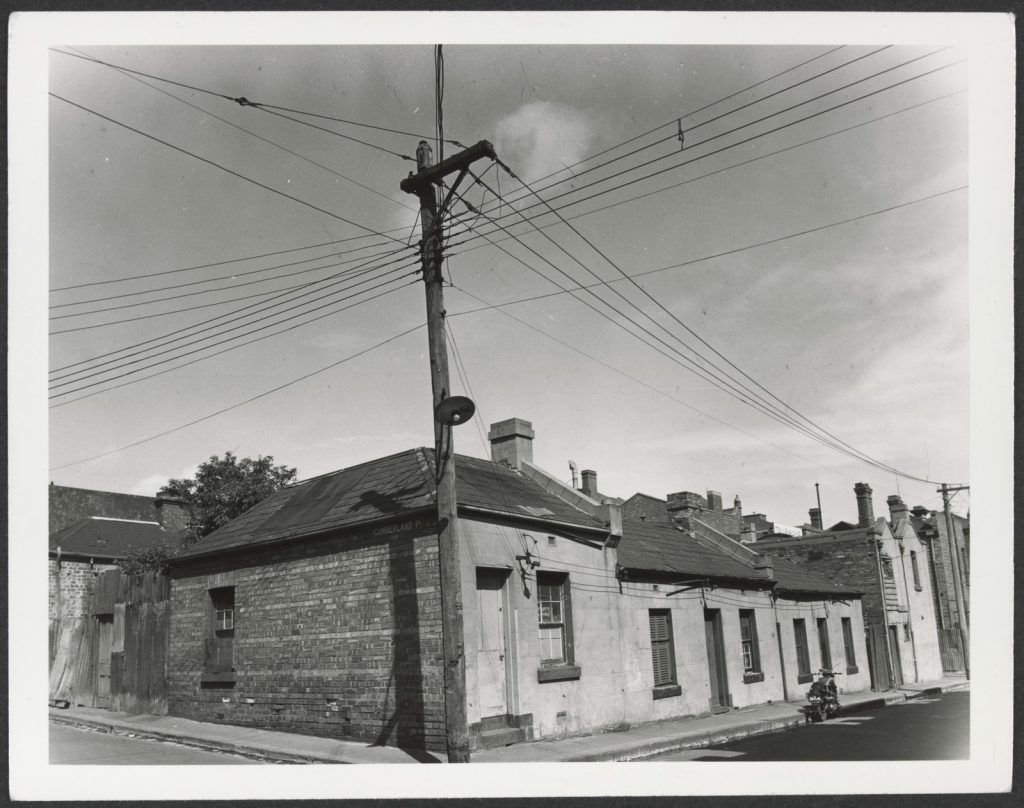
Little Lon had always been a working class neighbourhood, but an influx of poor and single women meant it soon gained a reputation for a different reason — as the leading red light district of Melbourne.
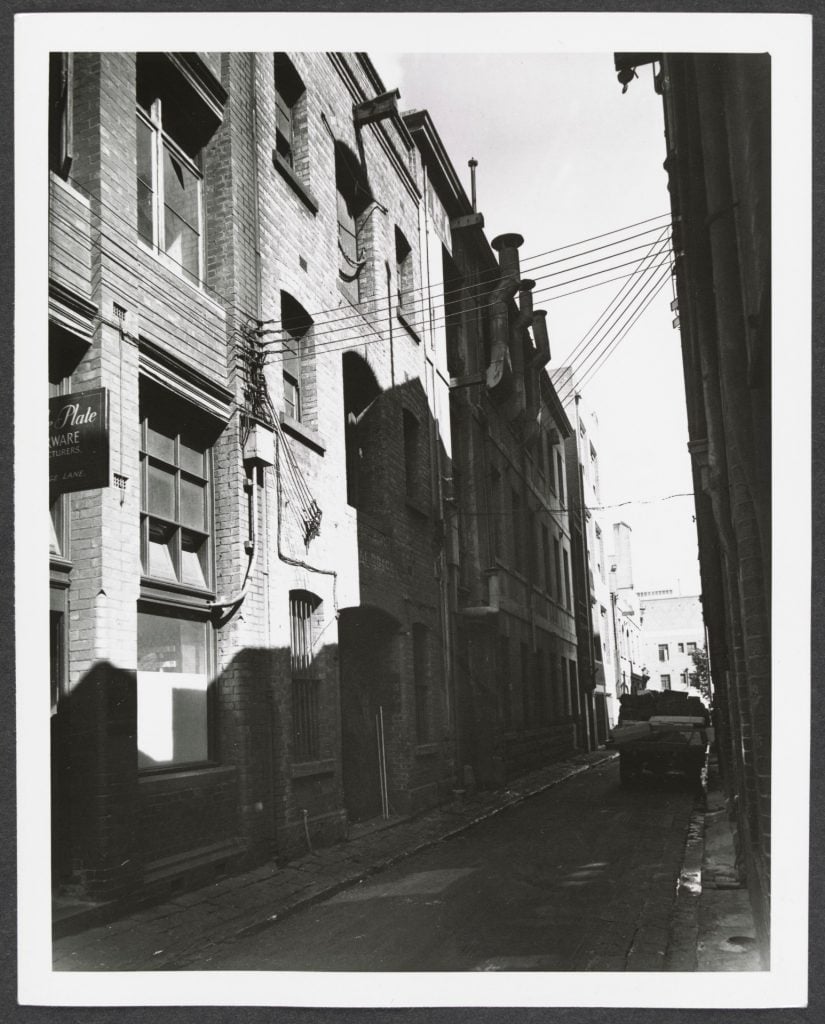
An 1883 Royal Commission into the state of the police force lamented the decline of public morals:
There is scarcely a suburb, or a street in the city, free from open and undisguised prostitution. Those disreputable houses are the recognised haunts of the vicious and criminal classes, for whose accommodation they are made accessible at all hours of the day and night (pp vii-viii).
Along with the brothels (politely termed ‘disorderly houses’, or ‘houses of ill fame’) came sensationalist newspaper reports of opium smoking, petty criminal activity, gambling houses and violent crime.

In 1889, the Herald reported that police were being called nightly to some ‘terrible dens’ where they found:
…attached to these disreputable establishments… large numbers of men and hoodlums, constituting a most dangerous element and responsible for the robberies and violent assaults on defenceless wayfarers… (p 1)
Presiding over these scenes of so-called debauchery was the infamous Caroline Hodgson aka ‘Madame Brussels’, who opened her first brothel in the precinct in 1874.3 She went on to run brothels in the area for thirty years.4
In the 1880s, Melbourne’s evangelists moved in, determined to ‘clean up’ Little Lon and ‘rescue’ its inhabitants. The Church of England’s Mission to the Streets and Lanes set up shop at number 30 Little Lonsdale Street, and for a while, St Vincent de Paul operated a home next door.5 In 1891 Sister Mary McKillop established a slum mission in Latrobe Street, and from 1897 the Salvos ran a women’s shelter named ‘Hope Hall’6 out of the building below:

Little Lon’s unsavoury reputation was all but cemented when rising poet C.J. Dennis burst onto the literary scene in 1915 with his best-selling verse novel, The songs of a sentimental bloke.7 Dennis riffed:
Wot’s in a name? Wot’s in a string o’ words?
They scraps in ole Verona with the’r swords,
An’ never give a bloke a stray dog’s chance,
An’ that’s Romance.
But when they deals it out wiv bricks an’ boots
In Little Lon, they’re low, degraded broots.8
Dennis’ Songs and his follow-up verses, The moods of Ginger Mick, enshrined the ‘scowlin’ slums’ of Little Lon in popular culture, with his lead character Bill (aka ‘the sentimental bloke’) spending his leisure time ‘gittin’ on the shick’, and his nights ‘down there, in Little Lon, Wiv Ginger Mick.’ 9
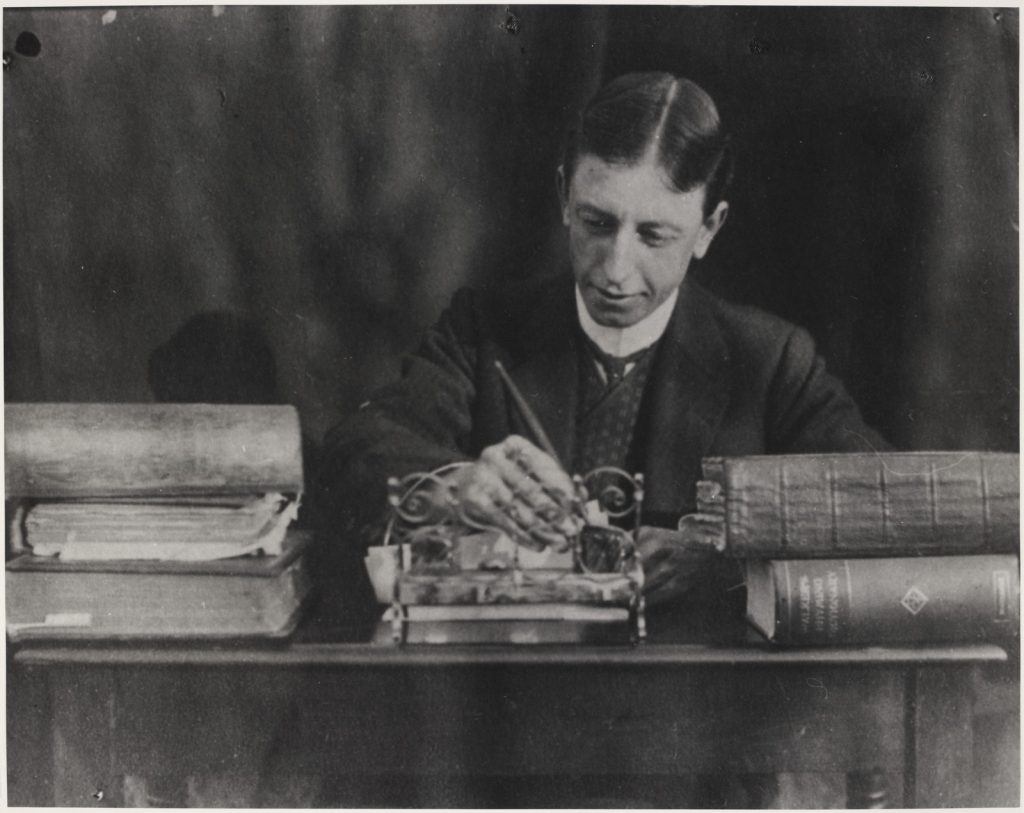
In the ensuing years, the campaign to ‘clean up’ Little Lon gathered apace, until Victoria’s Police Chief Commissioner, General Blamey, was forced to act, vowing to wipe out ‘the Little Lonsdale Street menace’ (Argus, 28 April 1932). 10
On 23 April 1932, the Truth newspaper reported that ‘the biggest vice raid in the history of Melbourne’ had been carried out in ‘the colony of doubtful sisterhood, known as Little Lonsdale Street’ (p 5).11
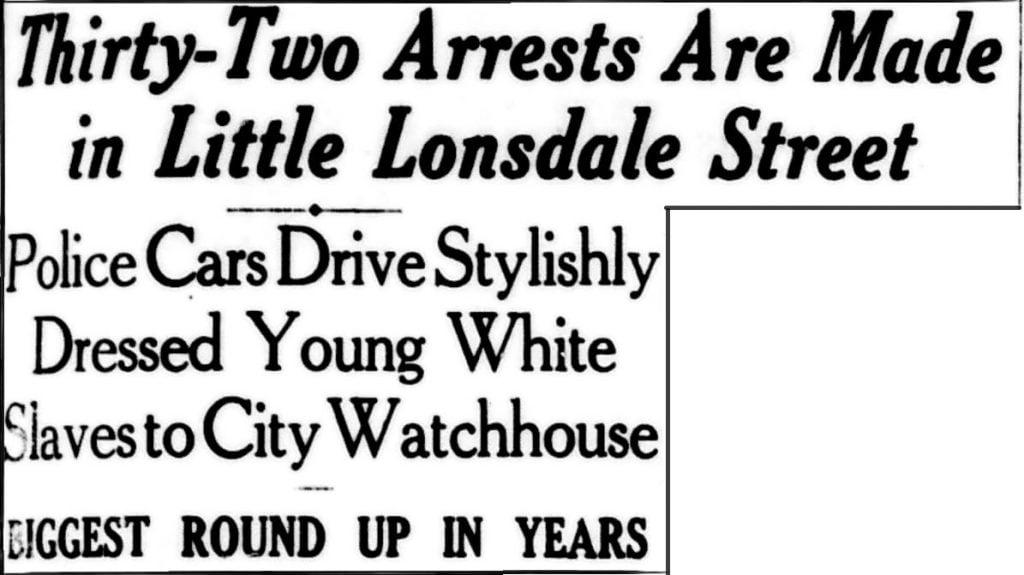
Thirty-two arrests were made, resulting in ‘a mannequin parade for the night staff at the watchhouse, dainty lace petticoats and silk stockings crowding the counter, while their owners feverishly struggled with paint and powder.’
The women were charged with vagrancy, but most escaped prosecution by demonstrating that they had money in the bank. Melbourne’s city by-laws were subsequently amended, much to the delight of the city’s newspapers and missionaries. ‘Little Lonsdale Street is doomed,’ the Truth newspaper crowed, ‘[t]he days of the Street of Evil are numbered’ (7 May 1932 p 1).12
It was the beginning of the end.
In 1948, the Commonwealth government compulsorily acquired the blocks that made up Little Lon. The northern block was razed in the ensuing decades and replaced by a giant Commonwealth government building. Locals branded it the ‘green latrine’, in a not-so-subtle dig at its phosphorescent green cladding.13
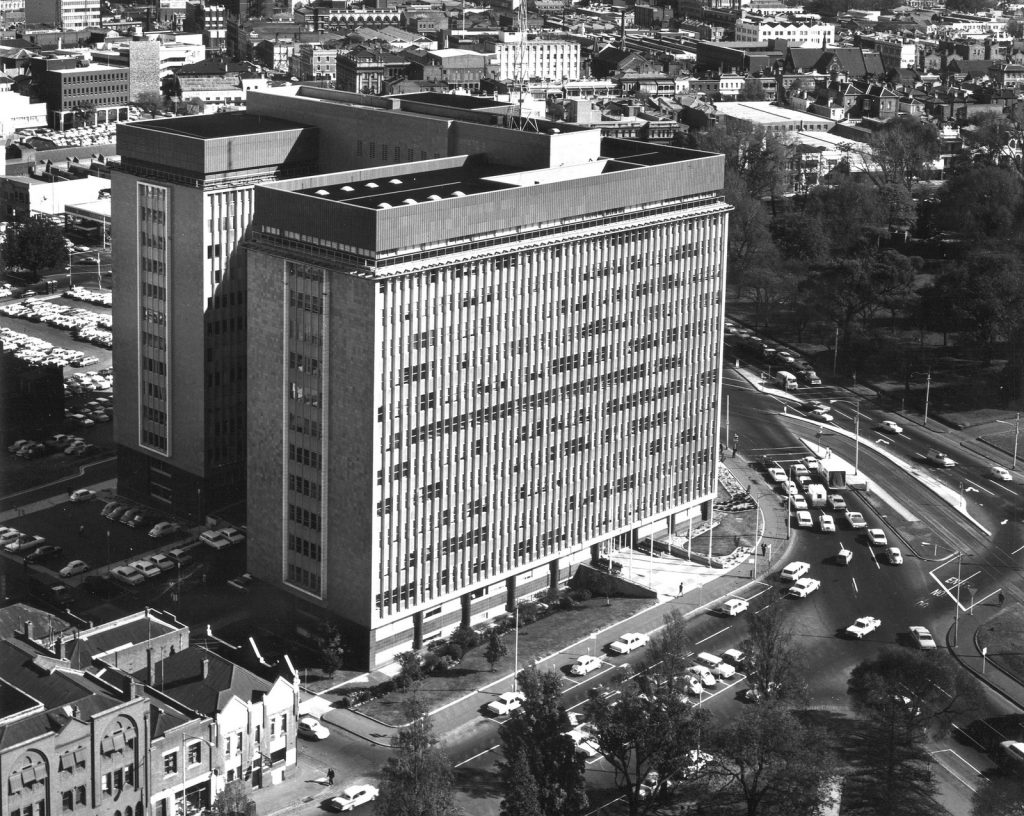
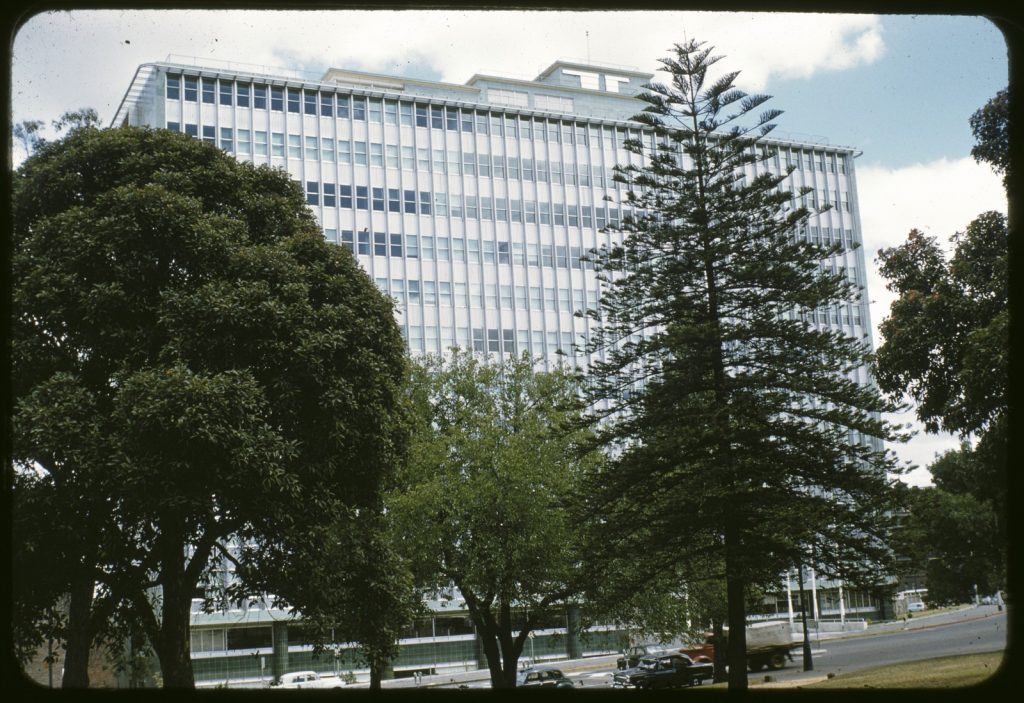
In the seventies, the rest of the precinct was bulldozed, and a huge telephone exchange was built in its place.14
Little Lon had a tawdry reputation in its day, but away from the salacious tabloid headlines, there existed another, less talked about side to the district. The precinct was one of the earliest examples of multicultural Melbourne, where immigrant communities built a new life together.15
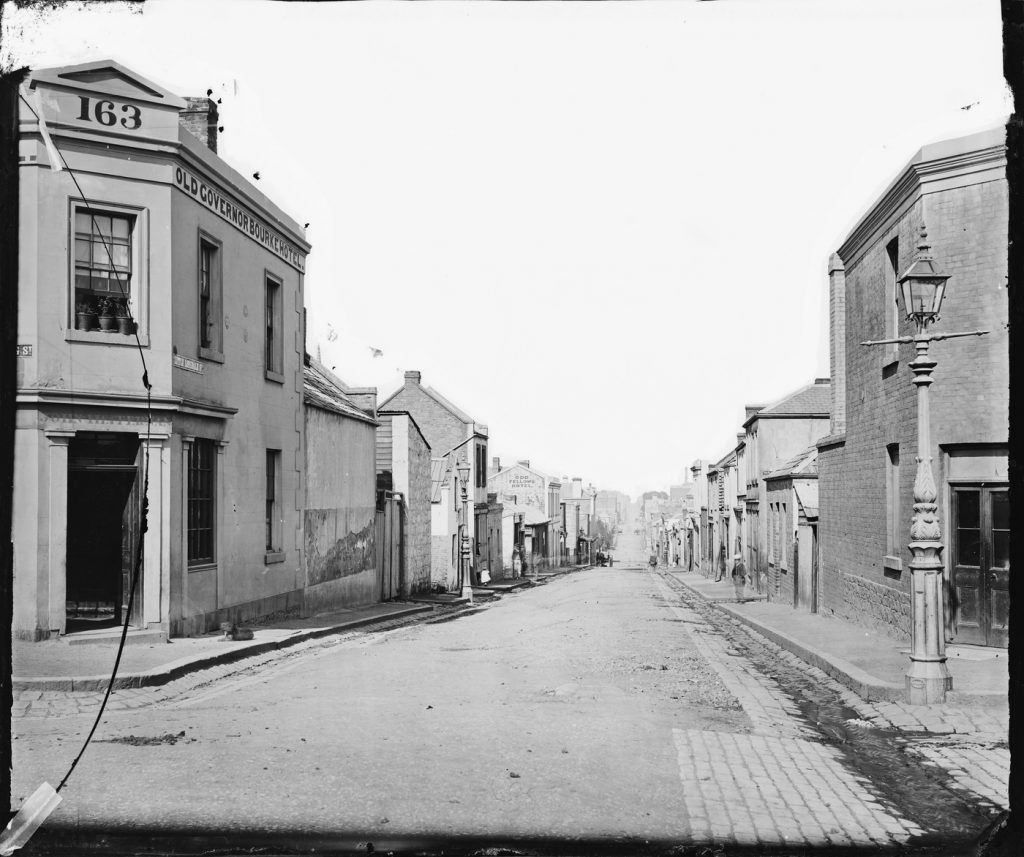
Postscript
In the 1950s, the Department of Housing and Construction took a series of photos of the Little Lon precinct. The photos have been digitised and you can view them online.
Further reading
Hayes, B. & Minchinton, B., 2020, ‘Sex and the sisterhood: how prostitution worked for women in 19th-century Melbourne,’ The Conversation
Leckey, J, 2004, Low, degraded broots? : Industry and entrepreneurialism in Melbourne’s Little Lon, 1860-1950
Mayne, A, & Murray, T, 1999, ‘ “In Little Lon… wiv Ginger Mick”: telling the forgotten history of a vanished community,’ Journal of Popular Culture, 33(1), pp 49-60
Melbourne City Council, 1992, ‘Heritage walk. 7. Little Lon’
References
- Mayne, A (2008) ‘Little Lon’, eMelbourne [website], accessed 1 April 2020.
- As above
- As above.
- Bentley, P (2006) ‘Caroline Hodgson (1851–1908)’, Australian Dictionary of Biography [website], accessed 15 March 2020.
- Mayne, A (2008) ‘Little Lon’, eMelbourne [website], accessed 1 April 2020.
- As above.
- Mayne, A, & Murray, T (1999) ‘ “In Little Lon… wiv Ginger Mick”: telling the forgotten history of a vanished community,’ Journal of Popular Culture, 33(1), pp 49-50.
- Dennis, C J (1915) The songs of a sentimental bloke, Angus & Robertson Ltd, Sydney, NSW, p 40.
- Mayne, A, & Murray, T (1999) ‘ “In Little Lon… wiv Ginger Mick”: telling the forgotten history of a vanished community,’ Journal of Popular Culture, 33(1), p 50.
- As above, p 51.
- As above.
- As above.
- As above, p 52.
- As above
- Mayne, A, & Murray, T (1999) ‘ “In Little Lon… wiv Ginger Mick”: telling the forgotten history of a vanished community,’ Journal of Popular Culture, 33(1), pp 49-60

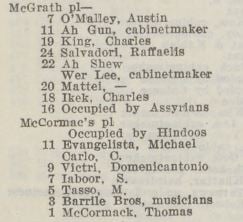

Thankyou Sarah,
It was an interesting read.
Romanticism of the past is a natural way to avoid thinking of terrible things inflicted on peoples lives. Poverty and hopelessness, that put people in a position to be exploited was the way of Melbourne before the “welfare state” came into existence. “Little Lon” may have been shut down but the “workers” were pushed into other parts of the City. Prostitution that even involved children was common and allowed by the “authorities” as long as they got their share of the money in my life time. The poverty that drove many peoples lives apart, and created children that nobody wanted or respected and could be raped without any regard to their humanity was part of the romantic Melbourne. Dare to remember, part of the romantic Melbourne right into the 1960’s the price for a six year old child sex worker on the street was four shillings; a loaf of bread and a bottle of milk. I leave the rest to your nightmares, about the talks of the romantic undeserving poor.
Very interesting thank you
Fantastic, would love to see more research articles about early Melbourne, and the inner suburbs of Melbourne.
Well done and very interesting, it reminded me of twelve photo’s my parents had of historic sights in Melbourne I think in about 1940’s, if your interested I can email them to you?
Hi Warren, Thanks for your interest. I will email you my contact details. Sarah
Thanks you so much Sarah – so interesting.
C.J. Dennis published the book “The Songs of a Sentimental Bloke” on 9 October 1915, during World War I, nearly six months after the ANZAC landing at Gallipoli. But most of the verse-chapters were published earlier.
In particular, “The Play”, Dennis’s tale of The Sentimental Bloke, Bill, taking his new girlfriend Doreen to see a performance of Shakespeare’s “Romeo and Juliet, with Bill (a larrikin and street-tough from “Little Lon”) who admires the brawling loutish larrikin young men of Verona — being a hardened street-fighter himself — was originally published in “The Bulletin”, 16 July 1914, p47.
Amusingly, watching the play, Bill mistakes the daggers used in the stage-fighting as “pocket-knives” and calls out, like someone barracking at the football — “Put in the boot!” — meaning, now that you’ve stabbed him, and he’s down, kick him!
Similarly, Chapter 1, “A Spring Song” first appeared in “The Bulletin” 13 March 1913, p43, under the title “Spring Song of a Bloke”. This was a year and a half before the war began in September 1914.
“The Spring Song” includes Bill’s Spring-time blues — he is pining for his “ideel tart”, not yet discovered. He describes himself:
Me, that ‘as done me stretch fer stoushin’ Johns,
An’ spen’s me leisure getting on the shick,
An’ ‘arf me nights down there in Little Lon.,
Wiv Ginger Mick,
Jist ‘eading ’em, an’ doing in me gilt.
Bill’s spelling reflects his accent (broad working-class Australian, known nowadays as “Strine” or “Strayun”. Importantly, Bill also uses LOTS of Australian slang, most of which was unknown to Dennis’s genteel readers (so he included a Glossary in his verse-novels), and almost all of this slang is now a barrier to appreciation by modern readers. Moreover, often Bill refers to things of his time and place that are now hopelessly obscure unless they are explained in footnotes, or annotations. (I have ePublished a complete Annotated edition of “The Songs of a Sentimental Bloke” at Amazon, and an Annotated edition of “The Moods of Ginger Mick”, explaining the slang and the historical references.
With the slang, Bill drops the “-g” at the end of “-ing”, as many Australians still do. He also drops the “h-” at the start of words like “have” — although this is, and was, more typical of London Cockney pronunciation.
For example, “stoushing” means fighting. It fell into obscurity for decades, but has since been revived by television journalists when referring, for example, to arguments between political parties in Canberra and other parliaments.
Bill’s “stretch for stoushin’ Johns” is a short prison sentence after being convicted of fighting police (nicknamed, at that time, “Johns”, short for “John ‘Ops” — rhyming slang for “cops”, itself a slang abbreviation of “coppers” — police officers who “cop”, that is, catch and arrest people doing bad things. Bill is a convicted petty criminal!
Bill describes himself as “getting on the shick”. This means, getting drunk.
The slang word “shickered” means being drunk. Bill’s (or Dennis’s!) variant “shick” is probably Dennis’s concoction, devised to rhyme, conveniently, with Bill’s best friend, another tougher larrikin (and barrow boy who roams the streets selling rabbits — cheap meat), Ginger Mick.
“Jist heading them …” refers to playing Two-Up, a traditional Australian gambling game.
“… doin’ in me gilt” means “losing my money”. The slang word “gilt” alludes to “gold”, but it is unlikely that Bill is losing actual gold coins — shillings and sixpences and other.
“Little Lon.”, with the full-stop, has been explained, but for non-Melbourne readers of Bill’s tale, an explanation of the street-grid created by surveyor Robert Hoddle, for Melbourne, with streets and major lanes named after royalty, aristocrats and leading politicians (starting with “Lord Melbourne” — Hoddle’s name was given later to a major street outside the central grid).
It should be stressed that the modern derogatory slang meaning of “tart” is “prostitute”. But Bill uses the word in total innocence, meaning “young woman”. His “ideel tart” is not a perfect prostate but a wonderfully attractive, and potentially woo-able single woman, preferably nice, young, and pretty.
“‘Er name’s Doreen… Well spare me bloomin’ days, yer could er knocked me darn wiv ‘arf a brick!”
I leave as homework the question, who was “Lonsdale”.
And what did the street label, “Little”, mean in lesser streets such as “Little Collins” and “Little Bourke”, and is this different from “Lane” in, for example, “Flinders Lane”?
Also: who were “Bourke”, “Collins” and “Flinders”?
And, was Dennis the first to speak of “Little Lon.”?
Full appreciation of C.J. Dennis’s verse-novel masterpieces depends on understanding his obsolete slang and his historically dated references.
In “The Moods of Ginger Mick”, there is a brilliant verse-chapter about a wild brawl in Ah Foo’s chop-house in Little Bourke Street’s famous China Town, when a drunken toff tries to pick up Mick’s girl, Rose of Spadgers. (“Spadgers” is, Spadgers Lane, a very seedy tiny lane that either no longer exists, or never existed. I have been able to find out, although I know that “spadger” is slang for “sparrow”. Equally, I have not found any record of “Sparrow Lane” or “Sparrows Lane” in early street maps of the Hoddle grid).
By the time the Johns arrive to break up the fight, Mick and Rose have escaped the melee, carrying away a roast chicken and a roast duck. They will enjoy their romantic dinner in the privacy of Rose’s lodgings.
Dr John Gough — Deakin University (retired)
At a recent screening of the 1919 film in Adelaide, nobody seemed fussed by the language though obviously some is over one’s head. We used the now-rare version of the film that has the 1959 piano accompaniment, itself linking back to 1919. Overall, a great success show.
I suspect your reference to prostate was an autocorrect of prostitute!
I think the use of Little was related to the grid pattern and to their standard width compared to the ‘big’ streets. But why Finders Lane when the other city lanes were smaller again?
My father did an apprenticeship in lift engineering and had a wonderful knowledge of the lanes because of access points for their hydraulic systems.
Could Spadger’s have been a rooming house?
CJ Dennis is much more easily understood spoken/acted than read, but is very enjoyable to oldies like me!
Many thanks for your excellent response.
loved reading about this area and the pictures also
Sarah,
Excellent article. I love the history of Melbourne and currently researching the history of Fitzroy and some of the industrial sites of the suburb. MacRobertsons Cholate factory was great reading so was the old channel nine TV studios. I guess being in isolating has some rewards. Cant think of too many. David
Excellent article, well done
I love this potted history of Melbourne. Please provide more of this type of resource whilst we are all in isolation. Thankyou Sarah and the Victorian State Library.
great to read our history of Melbourne, love to read more articles. great work.
Always fascinating hearing stories of our past citizens and how life was. Thank you
Enjoyable background on ‘Little Lon’. I’ll link to this in my first-year Monash University lecture on depictions of Melbourne in literature, particularly with reference to C.J. Dennis’ ‘Songs’. Any evocative pictures of late-19th / early 20thC back lane boys would help. I faintly recall there used to be a picture display of such where the street crosses Melbourne Central, but can’t find it online.
Hi Simone, Thanks for your interest. I will log your inquiry and one of our librarians will get back to you. Sarah
This is so interesting and poignant, and a great incentive to go and walk the area as soon as we ass allowed to do so! Much appreciated.
Great read, the building on the corner of little Lon and Russle street which was used as a women’s shelter started life as Melbournes earliest synagogue and is now a Restaurant after having been a city of Melbourne Crèche . Such a varied life
Thank you for an interesting story of ‘Little Lon’ and nostalgia photos. John Gough’s comments about C.J. Dennis’ ‘Sentimental Bloke’ were also interesting although I belong to the age group that would be familiar with most of the Australian slang used in the poem. I was lucky to be introduced to the ‘Bloke’, when my Grade 6 teacher used to read sections of it at the end of the school day.
Very interesting yet again Sarah, love your blogs they are always a good read.
I was just reading about this neighbourhood in the Miss Fisher mystery book, Unnatural Habits, by Kerry Greenwood. Fascinating coincidence to see the blog post at the same time.
So interesting Sarah. Beautifully put together and of historical interest.
Great insightful article Sarah. One of our family ancestors was the victim of in a ‘Murder in Lit Lon’ in 1865 (The Argus (Melbourne, Vic.:1848-1954), Friday 22 September 1865, page 7). This also depicts the difficulties of surviving life at the time, particularly the frustrations of the poorer citizens.
Thanks Sarah, that was a great piece of work, always enjoy looking into the past
A fabulous read Sarah! My ancestors coach building business was one of many compulsorily acquired as part the Commonwealth Block project, so always fascinated to read about the history of this colourful precinct.
Hi Sarah, I have been researching my family tree and came across your article about Little Lonsdale Street. I have discovered that my Great Grandfather, Michael McKiterick, owned a Grocery Shop at 12 Little Lonsdale Street (about 1885) and also my Great Grandmother, Mary McCormack (his wife), lived in McCormack Place (her family owned some of the properties in McCormack Place). Do you know if there are any photos of Little Lonsdale Street which would show where No 12 was?
Hi Anne, thanks for your interest. I will log your enquiry with our Ask a Librarian service and one of our librarians will be in touch. Sarah
Many thanks Sarah for your reply.
I worked at the Casselden Place for a few years and have always found the surrounding history fascinating.
Would appreciate any information on what business operated out of 149 Little Lonsdale street in 1932.
Thanks for your interest in our blog Garry. I will log your question with our Ask a Librarian service, and one of our librarians will get back to you. Sarah